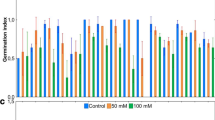Abstract
Root growth response of 10-days-oldseedlings of 100 maize accessions at, 0 mM, 60 mM, 80 mM and 150 mM NaCl concentration was assessed in solution culture. The non-linear least square method was used to quantify the salt tolerance of maize accessions. The estimated salinity threshold, Ct, the NaCl concentration at which root growth starts to decrease, C0, and C50, the concentrations at which roots stop growing and 50% of its control value revealed considerable differences between the accessions. No general consistency for tolerance was, however, found between the estimates of Ct and C50. Different genetic systems appeared to be involved in controlling the inheritance of Ct and C50.Both Ct and C50 appeared to quantify accession tolerance, and the expression of root growth as a function of NaCl concentrations provides a useful guideline for salt tolerance. Estimates of broad sense heritability for relative root length were moderate in size (0.62 to 0.82), suggesting the scope for enhancing salt tolerance in maize through selection and breeding.
Similar content being viewed by others
References
Al-Khatib, M., T. McNeilly & J.C. Collins, 1994. Between and within cultivar variability in salt tolerance in lucerne, (Medicago sativa L.). Gen Resour & Crop Evol 41: 159-164.
Ashraf, M. & T. McNeilly, 1989. Effect of salinity on some cultivars of maize. Maydica 34: 179-189.
Ashraf, M. & T. McNeilly, 1990. Improvement of salt tolerance in maize by selection and breeding. Plant Breeding 104: 101-107.
Ashraf, M., T. McNeilly & A.D. Bradshaw, 1986. The potential for evolution of salt tolerance in seven grass species. New Phytol 103: 299-309.
Ashraf, M., T. McNeilly & A.D. Bradshaw, 1987. Selection and heritability of tolerance to sodium chloride in four forage species. Crop Sci 27: 232-243.
Azhar, F.M. & T. McNeilly, 1987. Variability for salt tolerance in Sorghum bicolor (L.) Moench under hydroponic conditions. J Agron & Crop Sci 159: 269-277.
Bradshaw, A.D. & K. Hardwick, 1989. Evolution and stress-genotypic and phenotypic components. Biolo J Linn Soci 37: 137-155.
Cramer, G.R., E. Epstien & A. Läuchli, 1988. Kinetics of root elongation of maize in response to short-term exposure to NaCl and elevated calcium concentration. J Exp Bot 39: 1513-1522.
Epstein, E. & D.W. Rains, 1987. Advances in salt tolerance. Plant & Soil 99: 17-29.
Falconer, D.S. & T.F.C. Mackay, 1996. Introduction to Quantitative Genetics. Chapman and Hall, London.
Flowers, T.J., A. Garcia, M. Koyama & A.R. Yeo, 1997. Breeding for salt tolerance in crop plants-the role of molecular biology. Acta Physiologiae Plantarum 19: 427-433.
Flowers, T.J. & A.R. Yeo, 1995. Breeding for salinity resistance in crop plants: where next. Aust J Plant Physiol 22: 875-884.
Foolad, M.R., 1996. Response to selection for tolerance during germination in tomato seed derived from P1-174263. J Amer Soc Hort Sci 121: 1006-1011.
Hassnian, A.M. & M. Azab. 1993. Salt tolerance of grain sorghum. In: H. Lieth & A. Al-Masoom (Eds.), Towards the Rational Use of High Salinity Tolerant Plants, pp. 153-156. Kluwer Academic Publishers, Netherlands.
Hewitt, E.J., 1966. Sand and water culture methods used in the study of plant nutrition. Commonwealth Agriculture Bureaux. Technical Communication No. 22.
Kebebew, F. & T. McNeilly, 1995. Variation in response of accessions of minor millets, Pennisetum americanum (L.) Leeke (Pearl Millet) and Eleusine coracana (L.) gaertn (Finger Millet), and Eragrostis tef (Zucc.) trotter (Tef), to salinity in early seedling growth. Plant & Soil 175: 311-321.
Khan, A.A., 1999. Breeding Maize for Stress Tolerance. PhD Thesis. The University of Liverpool, UK.
Khan, A.A., T. McNeilly and F.M. Azhar, 2001. Stress tolerance in crop plants. (Review). Int J Agri Biol 3: 250-55.
Maas, E.V. & G.J. Hoffman, 1977. Crop salt tolerance current assessment. J Irrig & Drain Div ASCE 103: 115-134.
Maas, E.V., G.J. Hoffman, G.D. Chaba, J.A. Poss & M.C. Shannon, 1983. Salt sensitivity of corn at various growth stages. Irrig Sci 4: 45-57.
Maiti, R.K., L.E.D. Amaya, S.I. Cardona, A.M.O. Dimas, M. De La Rosa-Ibarra & H.D.L. Castillo, 1996. Genotypic variability in maize cultivars (Zea mays L.) for resistance to drought and salinity. J Plant Physiol 148: 741-744.
Martinez-Cob, A., R. Aragues & A. Royo, 1987. Salt tolerance of barley (Hordeum vulgare L.) cultivars at the germination stage: Analysis of response functions. Plant & Soil 104: 53-56.
Meigs, P. 1968. Deserts of the world. In: W.G. McGinnies, B.J. Goldman & P. Paylore (Eds.), An Appraisal of Research into Their Physical and Biological Environments. Uni. Arizona Press, Tucson. USA.
Paterniani, E., 1990. Maize breeding in tropics. Cri Rev Plant Sci 9: 125-154.
Rao, S.A., 1997. The Potential for Breeding Zea mays L. for Saline Conditions. Ph.D. Thesis, The University of Liverpool.
Rao, S.A. & T. McNeilly, 1999. Genetic basis of variation for salinity tolerance in maize (Zea mays L.). Euphytica 108: 145-150.
Shannon, M.C., 1985. Principles and strategies in breeding for salt tolerance. Plant & Soil 89: 227-241.
Saranga, Y., A. Cahaner, D. Zamir, A. Marani, A. & J. Rudich, 1992. Breeding tomatoes for salt tolerance: inheritance of salt tolerance and related traits in inter-specific populations. Theor Appl Genet 84: 90-396.
SPSS, 1994. Repeated Measure Analysis of Variance, pp. 107-143. In: SPSS Advance Statistics. Release 6.1.
Steppuhn, H., K. Wall, V. Rasiah & Y.M. Jame, 1996. Response functions for grain yield from spring-sown wheats grown in saline rooting media. Canad Agric Engin 38: 249-256.
van Genuchten, M.T., 1983. Analysis crop salt tolerance data: Model description and user manual USDA-ARS, ASSL, Riverside California. Research Report 120: 1-50.
van Genuchten, M.T. & G.J. Hoffman, 1984. Analysis of crop salt tolerance data. In: I. Shainberg & J. Shalevet (Eds.), Soil Salinity under Irrigation, pp. 258-271. Springer Verlag, Berlin.
Wallace, H.A. & E.N. Bressman, 1949. Corn and Corn Growing. John Wiley and Sons, New York.
Author information
Authors and Affiliations
Rights and permissions
About this article
Cite this article
Khan, A.A., Rao, S.A. & McNeilly, T. Assessment of salinity tolerance based upon seedling root growth response functions in maize (Zea mays L.). Euphytica 131, 81–89 (2003). https://doi.org/10.1023/A:1023054706489
Issue Date:
DOI: https://doi.org/10.1023/A:1023054706489




